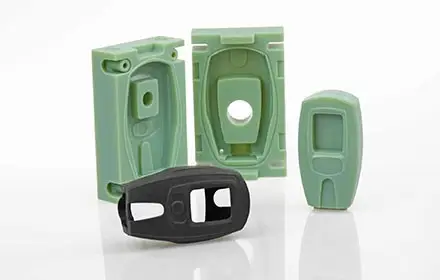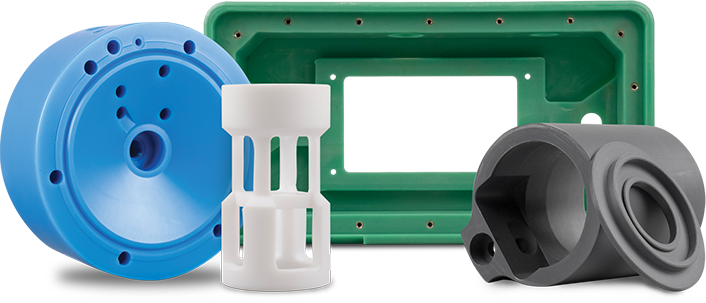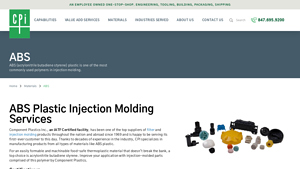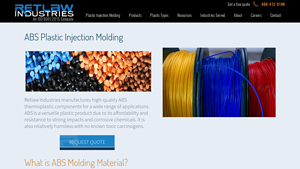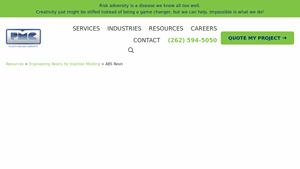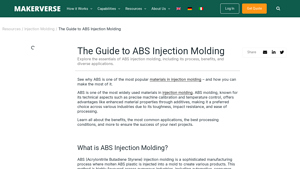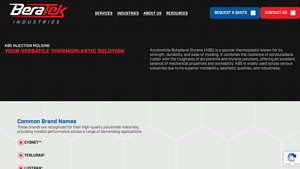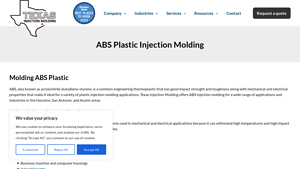Abs Molding Guide: Type, Cost, Top List…
Introduction: Navigating the Global Market for abs molding
In the competitive landscape of global manufacturing, sourcing high-quality ABS molding solutions can be a daunting challenge for B2B buyers. As industries increasingly rely on ABS (Acrylonitrile Butadiene Styrene) for its remarkable strength, lightweight properties, and versatility, understanding the nuances of this material and its molding processes becomes essential. This comprehensive guide delves into the multifaceted world of ABS molding, covering various types, applications across sectors such as automotive and consumer products, supplier vetting strategies, and cost considerations.
Designed specifically for international B2B buyers from regions like Africa, South America, the Middle East, and Europe, this guide aims to empower informed purchasing decisions. By providing actionable insights into the ABS molding process, industry best practices, and key factors to consider when selecting suppliers, we enable businesses to navigate the complexities of sourcing effectively. Whether you are looking to manufacture durable components or innovative designs, understanding the landscape of ABS molding will be pivotal in optimizing your supply chain and enhancing product quality.
Explore the rich content within this guide to ensure that your sourcing strategy aligns with market demands and leverages the full potential of ABS molding technologies. Your journey to efficient and cost-effective manufacturing begins here.
Understanding abs molding Types and Variations
| Type Name | Key Distinguishing Features | Primary B2B Applications | Brief Pros & Cons for Buyers |
|---|---|---|---|
| Standard Injection Molding | High-volume production, complex shapes | Automotive parts, consumer electronics | Pros: Cost-effective for large runs. Cons: High initial mold costs. |
| Thin Wall Injection Molding | Requires increased pressure, optimized cooling | Medical devices, packaging | Pros: Lightweight, efficient. Cons: Higher complexity in mold design. |
| Insert Molding | Combines plastic with metal or other materials | Electronics, automotive components | Pros: Enhanced strength and functionality. Cons: More complex tooling required. |
| Overmolding | Two or more materials in one part | Hand tools, appliances | Pros: Improved ergonomics and aesthetics. Cons: More expensive and intricate process. |
| Gas-Assisted Injection Molding | Uses gas to create hollow parts | Large automotive parts, furniture | Pros: Reduces weight and material use. Cons: Requires specialized machinery. |
What are the Characteristics of Standard Injection Molding?
Standard injection molding is the most common method for producing ABS components. It allows for the creation of intricate and complex shapes, making it suitable for a wide range of applications, including automotive parts and consumer electronics. B2B buyers should consider the high initial investment in mold design and machinery, which can be justified through large-scale production runs due to its cost-effectiveness.
How Does Thin Wall Injection Molding Work?
Thin wall injection molding focuses on producing lightweight parts with walls less than 1.5 mm thick. This technique is particularly effective for medical devices and packaging, where weight savings are crucial. However, buyers must be prepared for increased pressure requirements and optimized cooling processes, which can complicate mold design and manufacturing logistics.
What is Insert Molding and Its Benefits?
Insert molding involves placing metal or other materials into a mold before injecting ABS. This technique is widely used in electronics and automotive components, where enhanced strength and functionality are necessary. Buyers should note that while insert molding can improve product durability, it requires more complex tooling and higher upfront costs.
Why Choose Overmolding for Your Products?
Overmolding combines two different materials into a single part, often enhancing user comfort and product aesthetics. This method is prevalent in hand tools and appliances, where a soft grip is desirable. However, B2B buyers need to consider the increased complexity and cost associated with the overmolding process, which may not be suitable for all projects.
What Advantages Does Gas-Assisted Injection Molding Offer?
Gas-assisted injection molding employs gas to create hollow parts, significantly reducing weight and material use. This method is ideal for large components in industries like automotive and furniture. While it offers advantages in material efficiency, B2B buyers must recognize the need for specialized machinery and potential increases in production costs.
Key Industrial Applications of abs molding
| Industry/Sector | Specific Application of ABS Molding | Value/Benefit for the Business | Key Sourcing Considerations for this Application |
|---|---|---|---|
| Automotive | Dashboard Components | Lightweight, impact-resistant parts enhance safety and performance. | Supplier reliability, compliance with automotive standards, and production capacity. |
| Consumer Electronics | Housings for Devices (e.g., smartphones) | Durable, aesthetic finishes that attract consumers and withstand wear. | Customization options, quality assurance, and lead times for production. |
| Medical Devices | Surgical Instrument Handles | Provides strength and sterilization compatibility essential for safety. | Regulatory compliance, material certifications, and precision manufacturing capabilities. |
| Construction | Fittings and Fixtures | Cost-effective solutions for plumbing and electrical applications. | Availability of diverse grades, weather resistance, and bulk supply options. |
| Toys and Games | Educational and Construction Toys (e.g., LEGO) | Safe, colorful, and durable products that meet safety standards. | Safety certifications, design flexibility, and scalability for high-volume production. |
How is ABS Molding Applied in the Automotive Industry?
In the automotive sector, ABS molding is extensively used to create dashboard components, door trims, and various interior fittings. The lightweight nature of ABS contributes to improved fuel efficiency, while its impact resistance enhances passenger safety. International buyers, particularly from regions like Africa and South America, should prioritize suppliers that can meet stringent automotive standards and provide reliable production capabilities. Additionally, understanding local regulations regarding automotive parts is crucial for compliance and market entry.
What Role Does ABS Molding Play in Consumer Electronics?
ABS molding is critical in the production of housings for consumer electronics, such as smartphones and laptops. Its durability and aesthetic appeal make it a preferred choice for manufacturers aiming to create products that are both visually appealing and resistant to everyday wear and tear. For B2B buyers in Europe and the Middle East, sourcing ABS molded components requires attention to customization options and quality assurance processes to ensure that the final products meet consumer expectations.
How is ABS Molding Utilized in Medical Devices?
The medical industry leverages ABS molding for manufacturing surgical instrument handles and other medical components that require strength and sterilization compatibility. The ability to modify ABS to enhance its properties is particularly beneficial for creating specialized medical devices. International buyers must focus on suppliers who comply with medical regulations and can provide material certifications, ensuring that the products meet safety and efficacy standards.
In What Ways is ABS Molding Beneficial for Construction Applications?
In construction, ABS molding is used to produce fittings and fixtures for plumbing and electrical applications. Its lightweight and cost-effective nature makes it a favored choice among contractors. For buyers in emerging markets, understanding the availability of various ABS grades and their weather resistance capabilities is vital for ensuring long-term performance in diverse environmental conditions.
How Does ABS Molding Enhance Toys and Games Manufacturing?
ABS molding is instrumental in creating educational and construction toys, such as building blocks. Its safety, vibrant colors, and durability are essential for meeting the strict safety standards required in the toy industry. B2B buyers, especially from regions like Brazil and Vietnam, should focus on suppliers that offer safety certifications and design flexibility, allowing for innovative and appealing toy designs that capture the market’s attention.
3 Common User Pain Points for ‘abs molding’ & Their Solutions
Scenario 1: Quality Control Challenges in ABS Molding Production
The Problem: B2B buyers often struggle with inconsistent quality in ABS molded parts. This inconsistency can stem from variations in raw material quality, suboptimal mold design, or fluctuations in the injection molding process itself. For manufacturers in sectors like automotive or consumer electronics, where component reliability is paramount, these quality issues can lead to costly rework, increased waste, and ultimately, dissatisfied customers. Buyers may find themselves facing increased scrutiny from their clients or regulatory bodies, as defective parts can compromise safety and performance.
The Solution: To mitigate quality control issues, buyers should prioritize sourcing materials from reputable suppliers who adhere to stringent quality standards. Conducting regular audits of suppliers and requiring certifications can ensure the consistency of ABS materials. Furthermore, investing in advanced mold design techniques, such as simulation software, can help in identifying potential issues before production begins. Implementing a robust quality management system (QMS) that includes in-process inspections and end-of-line testing can catch defects early, reducing the risk of costly recalls or rework. By establishing clear specifications and tolerances during the design phase, manufacturers can ensure that their ABS molded parts meet the required performance standards.
Scenario 2: High Production Costs in ABS Injection Molding
The Problem: Many international B2B buyers face escalating production costs related to ABS injection molding, particularly when manufacturing in high volumes. Factors contributing to these rising costs include expensive machinery, high energy consumption, and the necessity for skilled labor. In regions like Africa and South America, where resources may be limited, these costs can be prohibitive, making it difficult for companies to compete effectively in the global marketplace.
The Solution: To address high production costs, companies can explore several strategies. First, optimizing the injection molding process through techniques like cycle time reduction and energy-efficient machinery can significantly lower operational costs. Investing in automation and robotics can also reduce labor costs while maintaining high precision and repeatability. Additionally, embracing lean manufacturing principles can help identify waste and streamline operations. Buyers should also consider collaborating with local manufacturers who can provide cost-effective solutions tailored to their specific market needs. This localized approach can enhance supply chain efficiency and reduce transportation costs, ultimately contributing to a more competitive pricing strategy.
Scenario 3: Limited Design Flexibility with ABS Molded Parts
The Problem: B2B buyers often encounter limitations in design flexibility when working with ABS molding. While ABS is versatile, the constraints of traditional injection molding processes can restrict innovative designs, particularly for complex geometries or multi-material applications. This can be frustrating for companies seeking to differentiate their products in a crowded market, especially in sectors like consumer electronics and automotive, where aesthetics and functionality are critical.
The Solution: To overcome design limitations, buyers should consider adopting advanced injection molding techniques such as overmolding or insert molding. These methods allow for the integration of multiple materials, enhancing the functionality and aesthetic appeal of the final product. Additionally, utilizing rapid prototyping technologies, such as 3D printing, can facilitate iterative design processes, enabling buyers to test and refine their concepts before committing to full-scale production. Collaborating with experienced mold designers who are knowledgeable about design for manufacturability (DFM) can also help ensure that innovative designs are feasible and cost-effective. By embracing these strategies, B2B buyers can unlock greater design flexibility, leading to more competitive and market-ready products.
Strategic Material Selection Guide for abs molding
What Are the Key Properties of Common Materials Used in ABS Molding?
When selecting materials for ABS molding, it is essential to consider their properties, advantages, disadvantages, and suitability for specific applications. Below are analyses of four common materials used in this process, tailored for international B2B buyers.
1. ABS (Acrylonitrile Butadiene Styrene)
Key Properties:
ABS is known for its excellent impact resistance, toughness, and ability to withstand a wide temperature range (up to about 80°C). It exhibits good chemical resistance, particularly against acids and bases.
Pros & Cons:
The primary advantage of ABS is its durability and ease of processing, making it suitable for high-volume production. However, it can be sensitive to UV radiation and may degrade over time if exposed to sunlight. Additionally, while ABS is relatively affordable, the initial investment for injection molding machinery can be high.
Impact on Application:
ABS is widely used in consumer electronics, automotive components, and household appliances. Its compatibility with various media makes it a versatile choice for many applications.
Considerations for International Buyers:
Buyers should ensure compliance with international standards such as ASTM and ISO. In regions like Africa and South America, where UV exposure may be more significant, selecting UV-stabilized grades of ABS can enhance product longevity.
2. ASA (Acrylonitrile Styrene Acrylate)
Key Properties:
ASA offers similar mechanical properties to ABS but with superior weather resistance and UV stability. It maintains its color and mechanical strength even under prolonged exposure to sunlight.
Pros & Cons:
The key advantage of ASA is its enhanced resistance to environmental factors, making it ideal for outdoor applications. However, it is typically more expensive than ABS, which may affect cost-sensitive projects.
Impact on Application:
ASA is often used for outdoor fixtures, automotive parts, and consumer goods that require durability against the elements. Its chemical resistance is comparable to ABS, making it suitable for similar applications.
Considerations for International Buyers:
When sourcing ASA, buyers should verify certifications that meet local regulations, especially in Europe, where stringent environmental standards are common.
3. PC (Polycarbonate)
Key Properties:
Polycarbonate is known for its high impact resistance and optical clarity. It can withstand temperatures up to 135°C and offers excellent dimensional stability.
Pros & Cons:
The main advantage of polycarbonate is its strength and versatility, making it suitable for applications requiring transparency and durability. However, it is more expensive than ABS and can be challenging to process due to its high viscosity.
Impact on Application:
PC is often used in applications such as safety goggles, automotive headlamps, and electronic housings. Its compatibility with various media makes it suitable for diverse environments.
Considerations for International Buyers:
Buyers should be aware of the specific processing requirements for polycarbonate, as improper handling can lead to defects. Compliance with safety standards is crucial, especially in the automotive and electronics sectors.
4. Nylon (Polyamide)
Key Properties:
Nylon exhibits excellent tensile strength, flexibility, and resistance to wear and abrasion. It can withstand temperatures up to 120°C and has good chemical resistance, particularly against oils and solvents.
Pros & Cons:
The key advantage of nylon is its mechanical strength and durability, making it suitable for high-stress applications. However, it can absorb moisture, which may affect dimensional stability and lead to warping during the molding process.
Impact on Application:
Nylon is commonly used in automotive parts, industrial applications, and consumer products where durability is critical. Its compatibility with various media, including oils, enhances its applicability in mechanical components.
Considerations for International Buyers:
Buyers should consider the moisture absorption characteristics of nylon and ensure proper storage and handling. Compliance with international standards is vital, particularly in regions with strict manufacturing regulations.
Summary Table of Material Selection for ABS Molding
| Material | Typical Use Case for abs molding | Key Advantage | Key Disadvantage/Limitation | Relative Cost (Low/Med/High) |
|---|---|---|---|---|
| ABS | Consumer electronics, automotive parts | Durable and easy to process | Sensitive to UV radiation | Medium |
| ASA | Outdoor fixtures, automotive components | Superior weather resistance | Higher cost than ABS | High |
| PC | Safety goggles, automotive headlamps | High impact resistance | More expensive and challenging to process | High |
| Nylon | Automotive parts, industrial applications | Excellent tensile strength | Moisture absorption affects stability | Medium |
This strategic material selection guide provides valuable insights for B2B buyers, enabling informed decisions that align with their specific application needs and regional considerations.
In-depth Look: Manufacturing Processes and Quality Assurance for abs molding
What Are the Main Stages of ABS Molding Manufacturing Processes?
The manufacturing process for ABS molding consists of several critical stages: material preparation, forming, assembly, and finishing. Each stage plays a vital role in ensuring the quality and performance of the final product.
How is Material Prepared for ABS Molding?
Material preparation begins with the selection of high-quality ABS resin pellets. These pellets are often sourced from reputable suppliers who comply with international standards. The pellets are then dried to remove moisture, which can adversely affect the molding process and lead to defects in the final product.
During this stage, manufacturers also consider the specific requirements of the final application. For instance, if the ABS parts require enhanced strength or impact resistance, additives such as glass fibers may be mixed with the resin. This customization ensures that the molded products meet the desired performance characteristics.
What Techniques Are Used in the Forming Stage of ABS Molding?
The forming stage primarily involves the injection molding process, where the prepared ABS material is melted and injected into a precisely designed mold under high pressure. This stage is crucial for achieving the desired dimensions and surface finish of the final product.
Key techniques in this stage include:
-
Thin Wall Injection Molding: This technique requires high pressure to ensure that the molten ABS fills the mold cavity effectively. The molds are designed to manage the increased pressure while maintaining even cooling to avoid defects.
-
Gas-Assisted Injection Molding: This method is beneficial for creating large or hollow parts. A gas is injected into the mold after the ABS has been introduced, helping to maintain uniform wall thickness and reduce material usage.
-
Overmolding and Insert Molding: These techniques allow for the integration of different materials or components into a single part, enhancing functionality and aesthetics.
How is Assembly Handled in ABS Molding?
After the molding process, assembly may be required for products that consist of multiple parts. This could involve joining molded ABS components with other materials, such as metal or additional plastics. Manufacturers often utilize automated assembly techniques to improve efficiency and reduce labor costs.
Quality control during assembly is critical, as even minor misalignments can impact the product’s performance. Automated inspection systems can be employed to verify that parts are assembled correctly before they proceed to the finishing stage.
What Finishing Processes Are Commonly Used in ABS Molding?
The finishing stage involves various processes that enhance the surface quality and functionality of ABS products. Common finishing techniques include:
-
Surface Treatment: ABS parts can be painted, electroplated, or coated to improve aesthetics and protect against environmental factors like UV exposure.
-
Trimming and Deburring: These processes remove excess material and sharp edges, ensuring that the final product is safe for end-users.
-
Quality Inspection: Before packaging, products undergo thorough inspections to ensure compliance with specifications and standards.
How is Quality Assurance Implemented in ABS Molding?
Quality assurance (QA) is paramount in the ABS molding process, particularly for B2B buyers seeking reliable suppliers. The QA process involves adhering to international standards and implementing systematic quality checkpoints throughout the manufacturing cycle.
What International Standards Are Relevant for ABS Molding Quality Control?
Several international standards guide quality assurance in ABS molding:
-
ISO 9001: This widely recognized standard outlines the requirements for a quality management system (QMS). Manufacturers certified to ISO 9001 demonstrate their commitment to delivering consistent quality products and services.
-
CE Marking: For products sold in Europe, CE marking indicates compliance with health, safety, and environmental protection standards.
-
API Standards: In industries such as oil and gas, API standards may apply to ensure that components meet stringent performance criteria.
What Are the Key Quality Control Checkpoints in ABS Molding?
Quality control checkpoints are essential in maintaining product integrity throughout the manufacturing process. Common checkpoints include:
-
Incoming Quality Control (IQC): Raw materials, such as ABS pellets, are inspected upon arrival to ensure they meet specified quality standards.
-
In-Process Quality Control (IPQC): During the molding process, parameters such as temperature, pressure, and cycle time are monitored to ensure consistency and quality.
-
Final Quality Control (FQC): Finished products undergo rigorous testing to verify that they meet design specifications and quality standards before shipment.
What Common Testing Methods Are Used in ABS Molding Quality Assurance?
Testing methods play a crucial role in verifying the performance and durability of ABS molded parts. Common tests include:
-
Mechanical Testing: This assesses properties such as tensile strength, impact resistance, and flexural strength to ensure the product can withstand operational stresses.
-
Dimensional Inspection: Using precision measurement tools, manufacturers verify that molded parts conform to specified dimensions and tolerances.
-
Visual Inspection: A thorough visual inspection checks for surface defects, color consistency, and overall appearance.
How Can B2B Buyers Verify Supplier Quality Control?
For international B2B buyers, verifying a supplier’s quality control measures is essential to ensure product reliability and compliance with standards. Here are some effective strategies:
-
Supplier Audits: Conducting regular audits of suppliers allows buyers to assess their quality management systems and production processes directly.
-
Quality Reports: Requesting quality assurance reports can provide insight into the supplier’s testing methods, results, and adherence to standards.
-
Third-Party Inspections: Engaging third-party inspection services can offer an unbiased evaluation of the supplier’s quality control practices.
What Are the Quality Control Nuances for International B2B Buyers?
When sourcing ABS molded products from international suppliers, particularly in regions like Africa, South America, the Middle East, and Europe, buyers must consider specific nuances:
-
Cultural Differences: Understanding the cultural approach to quality assurance in different regions can help navigate potential challenges and expectations.
-
Compliance with Local Regulations: Buyers should familiarize themselves with local regulations and standards that may differ from international norms.
-
Logistics and Supply Chain Considerations: Quality assurance extends beyond manufacturing; it includes transportation and handling. Ensuring that products are stored and transported under optimal conditions is crucial to maintaining quality.
In conclusion, the manufacturing processes and quality assurance practices for ABS molding are integral to producing high-quality products that meet international standards. By understanding these processes, B2B buyers can make informed decisions and establish reliable partnerships with suppliers.
Practical Sourcing Guide: A Step-by-Step Checklist for ‘abs molding’
To successfully procure ABS molding services, it’s essential to follow a structured approach that ensures quality and efficiency. This guide outlines the necessary steps for B2B buyers, particularly those operating in diverse regions like Africa, South America, the Middle East, and Europe.
Step 1: Define Your Technical Specifications
Clearly articulating your technical requirements is vital. Specify the dimensions, tolerances, and any specific performance characteristics your ABS molded parts must meet. This ensures that potential suppliers can accurately assess their capability to fulfill your order and reduces the chances of miscommunication later in the process.
Step 2: Research and Identify Potential Suppliers
Conduct thorough research to compile a list of potential suppliers. Utilize platforms like industry directories, trade shows, and referrals from industry peers to find manufacturers specializing in ABS molding. Focus on suppliers with a proven track record in your industry to ensure they understand the specific demands of your application.
Step 3: Evaluate Supplier Certifications
Before proceeding with any supplier, verify their certifications and compliance with industry standards. Look for ISO certifications, quality management systems, and specific compliance with safety regulations relevant to your sector. This step is crucial to ensure that the supplier adheres to the highest manufacturing and quality standards, which can directly impact your product’s reliability.
Step 4: Request Samples and Prototypes
Request samples or prototypes of ABS molded components to assess quality and functionality. This hands-on evaluation allows you to verify that the supplier can meet your specifications and quality expectations. Pay attention to details such as finish, dimensions, and any defects during this assessment phase.
Step 5: Assess Production Capacity and Lead Times
Understanding the supplier’s production capabilities and lead times is essential for planning your supply chain effectively. Inquire about their machinery, workforce expertise, and ability to scale production based on your needs. Ensure that their timelines align with your project schedules to avoid delays in product launches.
Step 6: Negotiate Pricing and Terms
Once you have shortlisted suppliers, engage in negotiations regarding pricing, payment terms, and delivery schedules. Be transparent about your budget while ensuring that you secure a fair deal that reflects the quality of service and materials provided. Consider potential long-term partnerships that could offer favorable terms for bulk orders.
Step 7: Establish a Clear Communication Plan
Effective communication is critical throughout the procurement process. Establish a clear plan for regular updates and feedback, including points of contact on both sides. This ensures that any issues can be promptly addressed, and adjustments can be made as necessary, fostering a collaborative relationship with your supplier.
By following this step-by-step checklist, B2B buyers can navigate the complexities of sourcing ABS molding services more effectively, ensuring a successful partnership with suppliers that meet their manufacturing needs.
Comprehensive Cost and Pricing Analysis for abs molding Sourcing
What Are the Key Cost Components in ABS Molding Sourcing?
Understanding the cost structure for ABS molding is critical for B2B buyers looking to optimize their sourcing strategies. The main cost components include materials, labor, manufacturing overhead, tooling, quality control (QC), logistics, and supplier margins.
-
Materials: The cost of ABS resin is influenced by global petroleum prices and the specific grade of ABS used. Buyers should consider the potential for price fluctuations and seek long-term agreements with suppliers to stabilize costs.
-
Labor: Labor costs can vary widely based on the manufacturing location. Countries with lower labor costs may offer competitive pricing, but it’s essential to consider the skill level and productivity of the workforce, which can impact overall quality.
-
Manufacturing Overhead: This includes utilities, equipment maintenance, and facility costs. Efficient operations can lower overhead, allowing suppliers to offer better pricing.
-
Tooling: Initial tooling costs can be substantial, especially for custom molds. Buyers should evaluate the minimum order quantity (MOQ) required to break even on these costs. Investing in high-quality tooling can lead to better long-term returns.
-
Quality Control: Ensuring that products meet specified standards can add to costs, but it’s a necessary investment to avoid costly recalls or quality issues. Certification processes may also be a factor, especially for industries like automotive or medical devices.
-
Logistics: Transportation costs depend on the distance from the manufacturer to the buyer, shipping methods, and applicable tariffs. Incoterms can significantly influence these costs, so understanding the terms of sale is crucial.
-
Margin: Supplier margins vary based on competition, market demand, and the value-added services they provide, such as design support or expedited shipping.
How Do Volume and Specifications Affect ABS Molding Pricing?
Volume plays a significant role in determining pricing. Higher order quantities typically lead to lower per-unit costs due to economies of scale. Conversely, small batch sizes may incur higher tooling and production costs, making it essential for buyers to assess their needs carefully.
Customization also impacts pricing. Complex designs or specific material requirements can increase production time and costs. Buyers should communicate their specifications clearly to receive accurate quotes and avoid unexpected expenses.
What Buyer Strategies Can Enhance Cost-Efficiency in ABS Molding Sourcing?
-
Negotiation: Building strong relationships with suppliers can create opportunities for better pricing and terms. Engaging in open discussions about volume and future orders can lead to discounts or favorable payment terms.
-
Total Cost of Ownership (TCO): Buyers should consider the TCO, which includes not only the purchase price but also shipping, storage, and potential rework costs. A cheaper initial price may not always be the most cost-effective choice in the long run.
-
Understanding Pricing Nuances for International Sourcing: Buyers from regions like Africa, South America, the Middle East, and Europe should be aware of local market conditions, currency fluctuations, and geopolitical factors that could affect pricing.
-
Supplier Diversification: Engaging multiple suppliers can foster competitive pricing and reduce reliance on a single source. This strategy can also mitigate risks associated with supply chain disruptions.
-
Quality Assurance: Investing in quality assurance processes can prevent losses from defective products, which often outweigh initial savings from lower-quality sourcing.
What Should Buyers Keep in Mind About Pricing Discrepancies?
It’s essential for buyers to remember that prices can vary significantly based on geographic location, supplier reputation, and market demand. While indicative prices may be available, they should be treated as guidelines rather than fixed quotes.
Moreover, keeping abreast of market trends, such as shifts in raw material costs or changes in manufacturing capabilities, can empower buyers to make informed decisions that align with their business objectives.
By understanding these cost components and pricing influencers, B2B buyers can enhance their sourcing strategies for ABS molding, ultimately leading to improved profitability and operational efficiency.
Alternatives Analysis: Comparing abs molding With Other Solutions
Understanding Alternatives to ABS Molding
In the world of manufacturing, particularly in producing plastic components, ABS molding is a widely recognized method. However, it is essential for B2B buyers to explore alternatives that may better suit their specific needs. This section compares ABS molding with two other viable manufacturing solutions: Polypropylene (PP) Injection Molding and Thermoforming. Each method has its unique advantages and drawbacks, making it crucial to understand these differences.
| Comparison Aspect | Abs Molding | Polypropylene (PP) Injection Molding | Thermoforming |
|---|---|---|---|
| Performance | High impact resistance; good surface finish | Excellent chemical resistance; flexible | Good for large parts; less detail |
| Cost | Moderate initial investment; cost-effective for high volume | Generally lower material costs; similar setup costs | Lower tooling costs; economical for low to medium volumes |
| Ease of Implementation | Requires precise tooling; complex setup | Simpler tooling requirements; faster to set up | Easier to implement; less complex processes |
| Maintenance | Moderate; requires regular checks of molds | Low; less wear on tools due to softer material | Low; minimal maintenance needed for molds |
| Best Use Case | Automotive parts, consumer goods, electronics | Food packaging, medical supplies, automotive | Large panels, packaging, and prototypes |
What Are the Pros and Cons of Polypropylene Injection Molding?
Polypropylene (PP) injection molding is a notable alternative due to its favorable properties. It is highly resistant to chemicals and moisture, making it suitable for applications in food packaging and medical devices. PP is generally less expensive than ABS, especially in terms of raw material costs. However, it has a lower impact resistance compared to ABS, which may limit its use in high-stress applications. The tooling for PP is simpler and faster to set up, making it an attractive choice for businesses looking to streamline their processes. However, the trade-off may include a lesser surface finish and durability.
How Does Thermoforming Compare as an Alternative?
Thermoforming is another alternative that offers unique advantages, especially for producing larger parts. This method involves heating a plastic sheet until it becomes pliable and then forming it over a mold. Thermoforming is particularly cost-effective for low to medium production volumes due to its lower tooling costs. It’s also easier to implement compared to injection molding, which can be complex. However, the downside is that thermoformed products typically lack the fine detail and strength that ABS molded parts provide, making them less suitable for precision applications. They are often used in packaging and large panels where high detail is not critical.
How Can B2B Buyers Choose the Right Solution?
When selecting a manufacturing method, B2B buyers should carefully evaluate their specific requirements, including the desired performance characteristics, production volume, and budget constraints. ABS molding offers excellent durability and surface finish for high-volume applications, particularly in industries like automotive and electronics. In contrast, polypropylene injection molding may be more suitable for applications requiring chemical resistance and cost-effectiveness. Thermoforming stands out for large-scale production of simpler parts, making it ideal for packaging. By analyzing these factors, buyers can make informed decisions that align with their operational goals and product specifications.
Essential Technical Properties and Trade Terminology for abs molding
What Are the Key Technical Properties of ABS Molding?
Understanding the essential technical properties of ABS molding is crucial for B2B buyers, as these specifications directly impact product performance, cost, and manufacturability. Here are some critical properties to consider:
1. Material Grade
Material grades of ABS can vary significantly, affecting mechanical properties such as impact resistance, heat resistance, and surface finish. For instance, high-impact ABS (HI-ABS) is preferred for applications requiring superior toughness. Choosing the right grade ensures that the final product meets industry standards and customer expectations.
2. Tolerance
Tolerance refers to the allowable variation in dimensions during manufacturing. In ABS molding, tight tolerances (often ±0.005 inches or less) are essential for ensuring that parts fit together properly, especially in complex assemblies like automotive components. A clear understanding of tolerance requirements can minimize defects, reduce rework costs, and enhance overall product reliability.
3. Wall Thickness
The wall thickness of ABS parts influences their strength, weight, and manufacturing efficiency. Standard wall thickness ranges from 1 mm to 5 mm, depending on the application. Understanding the implications of wall thickness is vital for optimizing material usage and ensuring structural integrity while minimizing production costs.
4. Melt Flow Rate (MFR)
Melt flow rate indicates how easily the ABS material can be processed during injection molding. A higher MFR facilitates faster production cycles, which is advantageous for high-volume orders. However, it can also affect the mechanical properties of the final product. Selecting the right MFR is essential for balancing production efficiency and product performance.
5. Impact Resistance
ABS is known for its excellent impact resistance, making it suitable for applications where durability is critical. This property is particularly important in industries such as automotive and consumer electronics, where products are subjected to physical stress. Understanding the impact resistance of different ABS grades helps buyers select materials that can withstand real-world conditions.
6. Chemical Resistance
ABS exhibits good resistance to various chemicals, but it can be affected by prolonged exposure to solvents and aggressive chemicals. Knowing the chemical environment in which the final product will be used is crucial for making informed material choices that prevent premature failure.
What Common Trade Terms Should B2B Buyers Know in ABS Molding?
Familiarity with industry jargon can significantly streamline communication between buyers and suppliers. Here are some common terms relevant to ABS molding:
1. OEM (Original Equipment Manufacturer)
OEM refers to companies that produce parts or equipment that may be marketed by another manufacturer. Understanding OEM specifications is critical for ensuring that components meet the quality and performance standards expected in the final product.
2. MOQ (Minimum Order Quantity)
MOQ is the minimum number of units a supplier is willing to produce for a specific order. This term is crucial for B2B buyers to understand, as it can affect production planning and inventory management. Negotiating MOQs can lead to cost savings but may require strategic planning to meet the supplier’s requirements.
3. RFQ (Request for Quotation)
An RFQ is a formal document requesting price quotes from suppliers for specific products or services. B2B buyers should be prepared to provide detailed specifications, including material grades, tolerances, and quantities, to receive accurate quotes that facilitate informed purchasing decisions.
4. Incoterms (International Commercial Terms)
Incoterms are standardized trade terms that define the responsibilities of buyers and sellers in international transactions, including shipping, insurance, and tariffs. Familiarity with these terms is essential for B2B buyers to avoid misunderstandings and ensure smooth logistics.
5. DFM (Design for Manufacturing)
DFM refers to the principles of designing products in a way that simplifies manufacturing processes. By adhering to DFM guidelines, buyers can optimize product designs for cost-effectiveness and manufacturability, ultimately improving the production timeline and reducing waste.
6. Lead Time
Lead time is the period from placing an order to receiving the finished product. Understanding lead times is crucial for effective supply chain management, as it helps buyers plan inventory levels and meet market demands without overstocking or stockouts.
By grasping these technical properties and trade terminologies, B2B buyers can make informed decisions, enhance communication with suppliers, and ultimately achieve their production goals more efficiently.
Navigating Market Dynamics and Sourcing Trends in the abs molding Sector
What Are the Key Trends Influencing the ABS Molding Market?
The global ABS molding market is witnessing dynamic shifts driven by several factors. The increasing demand for lightweight, durable materials in the automotive and consumer goods sectors is a significant driver. As countries in Africa, South America, and the Middle East industrialize, the need for cost-effective manufacturing solutions grows. For instance, Brazil and Vietnam are ramping up their manufacturing capabilities, leading to an uptick in ABS applications across various industries, including electronics and medical devices.
Emerging technologies such as Industry 4.0 and the Internet of Things (IoT) are enhancing the efficiency of the ABS molding process. Automation and real-time monitoring are becoming standard, allowing manufacturers to optimize production schedules and reduce downtime. Additionally, advancements in additive manufacturing are facilitating rapid prototyping and customized solutions, which are crucial for international buyers looking to differentiate their products in competitive markets.
Another significant trend is the shift towards digital sourcing platforms, which streamline the procurement process for international B2B buyers. These platforms enable buyers to compare suppliers, obtain quotes, and manage logistics more effectively, fostering a more competitive landscape. As the market continues to evolve, understanding these dynamics will be essential for businesses aiming to leverage ABS molding technologies for their product offerings.
How Can B2B Buyers Address Sustainability and Ethical Sourcing in ABS Molding?
Sustainability is increasingly becoming a cornerstone of manufacturing practices, including ABS molding. The environmental impact of plastic production cannot be overlooked, prompting buyers to seek suppliers that prioritize eco-friendly practices. This includes the use of recycled ABS materials and energy-efficient manufacturing processes, which help reduce the carbon footprint associated with production.
Ethical sourcing is equally important, as international buyers must ensure their supply chains are transparent and responsible. This involves selecting suppliers who adhere to labor laws and promote fair working conditions. Certifications such as ISO 14001 for environmental management and ISO 9001 for quality management can serve as indicators of a supplier’s commitment to sustainability and ethical practices.
Moreover, buyers can explore innovative materials and processes that align with green initiatives. For instance, using bio-based ABS alternatives or investing in closed-loop recycling systems can significantly minimize waste and environmental impact. By prioritizing sustainability and ethical sourcing, companies can not only enhance their brand image but also meet the growing consumer demand for responsible manufacturing practices.
What Is the Historical Context of ABS Molding Relevant to B2B Buyers?
ABS molding has its roots in the mid-20th century, emerging as a popular choice for manufacturers due to its versatility and strength. Initially utilized in the automotive sector, the applications of ABS expanded rapidly to include consumer products, electronics, and medical devices. This evolution was largely driven by the material’s excellent impact resistance and ease of processing, which made it suitable for mass production.
As global manufacturing practices advanced, so did the techniques used in ABS molding. Innovations such as gas-assisted injection molding and multi-material molding have allowed for more complex designs and higher efficiency. Understanding this historical context is crucial for B2B buyers as it highlights the material’s proven track record and adaptability, reinforcing its relevance in today’s manufacturing landscape. By leveraging the advancements in ABS molding technology, businesses can position themselves competitively in the market while addressing the demands of modern consumers.
Frequently Asked Questions (FAQs) for B2B Buyers of abs molding
-
How do I choose the right ABS molding supplier?
Choosing the right ABS molding supplier involves several critical steps. Start by assessing their expertise in ABS materials and injection molding processes. Look for suppliers with a proven track record and positive reviews from previous clients. It’s also essential to evaluate their production capabilities, including technology used, quality assurance measures, and lead times. Request samples of their work to assess the quality firsthand. Finally, consider their communication responsiveness and willingness to collaborate on design and customization to ensure they meet your specific needs. -
What are the minimum order quantities (MOQ) for ABS molding?
Minimum order quantities for ABS molding can vary significantly based on the supplier and the complexity of the parts being produced. Typically, MOQs range from a few hundred to several thousand units. For high-volume production, suppliers often have lower MOQs due to the cost-effectiveness of running large batches. However, for custom or intricate designs, the MOQ may be higher to cover tooling and setup costs. Always discuss MOQs upfront with potential suppliers to align your production needs with their capabilities. -
What payment terms should I expect when sourcing ABS molding?
Payment terms for ABS molding can differ between suppliers and regions. Common terms may include a deposit (usually 30-50%) upfront with the balance due upon completion or before shipment. Some suppliers may offer net payment terms based on creditworthiness. For international transactions, consider using secure payment methods such as letters of credit or escrow services to protect both parties. Always clarify payment terms and conditions in the contract to avoid misunderstandings later. -
What are the key quality assurance practices in ABS molding?
Quality assurance in ABS molding includes several practices to ensure the final products meet specified standards. This typically involves pre-production trials, in-process inspections, and final product testing. Look for suppliers who utilize statistical process control (SPC) techniques to monitor production quality. Certifications such as ISO 9001 can indicate a commitment to quality management systems. Additionally, inquire about their ability to provide quality reports and documentation for compliance with industry standards. -
How can I customize ABS molded parts to fit my requirements?
Customization of ABS molded parts is achievable through various design and manufacturing techniques. You can specify dimensions, colors, and surface finishes during the design phase. Suppliers often provide design for manufacturability (DFM) consultations to ensure your designs are optimized for the molding process. Consider using insert molding or overmolding for multi-material components. Discuss your specific needs with your supplier to explore available customization options that align with your project goals. -
What logistics considerations should I keep in mind when sourcing ABS molding internationally?
When sourcing ABS molding internationally, logistics play a crucial role in ensuring timely delivery. Factors to consider include shipping methods (air vs. sea), customs regulations, and potential tariffs or duties. Work closely with your supplier to understand their shipping schedules and lead times. It’s also beneficial to establish a reliable logistics partner who can manage the complexities of international shipping, including tracking shipments and handling any customs issues that may arise. -
What are the environmental considerations when using ABS molding?
Environmental considerations for ABS molding include the material’s recyclability and the sustainability practices of your supplier. While ABS is recyclable, it’s essential to inquire about the supplier’s waste management processes and commitment to reducing environmental impact. Look for suppliers that implement eco-friendly practices such as using recycled materials or adopting energy-efficient production methods. Understanding these aspects can help you align your sourcing decisions with your company’s sustainability goals. -
How do I evaluate the technical capabilities of an ABS molding supplier?
Evaluating the technical capabilities of an ABS molding supplier involves assessing their equipment, technology, and expertise. Inquire about the types of injection molding machines they use, as well as their ability to handle complex designs and multi-material parts. Check if they have the capacity for rapid prototyping and tooling, which can significantly reduce time-to-market for new products. Additionally, request information on their engineering support, including design assistance and troubleshooting capabilities, to ensure they can meet your project requirements effectively.
Important Disclaimer & Terms of Use
⚠️ Important Disclaimer
The information provided in this guide, including content regarding manufacturers, technical specifications, and market analysis, is for informational and educational purposes only. It does not constitute professional procurement advice, financial advice, or legal advice.
While we have made every effort to ensure the accuracy and timeliness of the information, we are not responsible for any errors, omissions, or outdated information. Market conditions, company details, and technical standards are subject to change.
B2B buyers must conduct their own independent and thorough due diligence before making any purchasing decisions. This includes contacting suppliers directly, verifying certifications, requesting samples, and seeking professional consultation. The risk of relying on any information in this guide is borne solely by the reader.
Top 7 Abs Molding Manufacturers & Suppliers List
1. Protolabs – ABS Injection Molding
Domain: protolabs.com
Registered: 2006 (19 years)
Introduction: ABS Injection Molding offers high heat resistance, strength, durability, and low cost, making ABS a versatile material for plastic parts. The materials are opaque thermoplastics available in black and natural color options. Various grades of ABS for injection molding include Polylac, Cycolac, and RTP. Maximum part size is 18.9 in. x 29.6 in. x 8 in. (480mm x 751mm x 203mm) with a maximum volume of…
2. CPI Elgin – ABS Plastic Solutions
Domain: cpielgin.com
Registered: 1999 (26 years)
Introduction: ABS (acrylonitrile butadiene styrene) plastic is a commonly used polymer in injection molding, known for its low cost and high durability. It features a shiny, resistant surface and is tough even at low temperatures. ABS is available in fire-retardant and heat-resistant grades, making it suitable for food processing and storage. Applications include plumbing components, housings, covers, instrumen…
3. Retlaw Industries – ABS Plastic Injection Molding
Domain: retlawindustries.com
Registered: 2002 (23 years)
Introduction: ABS Plastic Injection Molding Service by Retlaw Industries Inc. offers high-quality ABS thermoplastic components for various applications. Key characteristics of ABS include affordability, strong impact resistance, heat resistance, high tensile strength, shock absorbance, scratch resistance, and recyclability. ABS is a thermoplastic polymer made from acrylonitrile, butadiene, and styrene, with a m…
4. PMC Plastics – ABS Resin Solutions
Domain: pmcplastics.com
Registered: 1999 (26 years)
Introduction: ABS Resin Characteristics & Uses: ABS Resin is used for a wide variety of molding services including New Product Design & Development, Plastic Injection Molding, Consulting, Plastic Overmolding, Insert Molding, Plastic Welding, and Post Molding Operations. Material Data Sheet: Chemical Name: Acrylonitrile Butadiene Styrene; Structure: Amorphous; Opacity: Clear to Opaque; Tensile Strength: 6030 PSI…
5. Makerverse – ABS Thermoplastic
Domain: makerverse.com
Registered: 2012 (13 years)
Introduction: ABS (Acrylonitrile Butadiene Styrene) is a thermoplastic polymer known for its outstanding impact resistance, chemical resistance, and high-gloss finish. It is widely used in injection molding due to its toughness, ease of processing, and dimensional stability. Key benefits include: toughness and impact resistance, ease of processing, dimensional stability, aesthetic versatility, and cost-effectiv…
6. Beratekin Industries – ABS Thermoplastic
Domain: beratekindustries.com
Registered: 2014 (11 years)
Introduction: ABS (Acrylonitrile Butadiene Styrene) is a versatile thermoplastic known for its strength, durability, and ease of molding. It combines the resilience of polybutadiene rubber with the toughness of acrylonitrile and styrene polymers, offering excellent mechanical properties and workability. Key characteristics include:
– **Moldability**: Easy to process, allowing for high precision and complex desi…
7. Texas Injection Molding – ABS Injection Molding
Domain: texasinjectionmolding.com
Registered: 2013 (12 years)
Introduction: {“Product Name”: “ABS Injection Molding”, “Material”: “Acrylonitrile-butadiene-styrene (ABS)”, “Properties”: [“Good impact strength”, “Good rigidity”, “Good surface appearance”, “FDA and U.L. grades available”, “Ultraviolet light sensitive; requires stabilizers for weatherability”], “Applications”: [“Medical devices”, “Electrical and electronics”, “Hardware enclosures”, “Business machine and compu…
Strategic Sourcing Conclusion and Outlook for abs molding
In conclusion, strategic sourcing in ABS molding presents a unique opportunity for international B2B buyers to optimize their supply chain and enhance product quality. By understanding the intricacies of ABS injection molding—its versatility, efficiency, and cost-effectiveness—buyers can make informed decisions that align with their manufacturing needs.
Key takeaways include the importance of selecting reliable suppliers who adhere to stringent quality standards and can accommodate diverse design requirements. Additionally, leveraging advanced techniques such as overmolding and insert molding can lead to innovative product solutions that meet market demands.
As the global market continues to evolve, particularly in regions like Africa, South America, the Middle East, and Europe, staying ahead of trends in ABS molding will be crucial. By prioritizing strategic sourcing, businesses can not only reduce costs but also enhance their competitive edge in their respective industries.
Moving forward, consider taking actionable steps towards building partnerships with reputable ABS molding suppliers. This proactive approach will empower your organization to capitalize on the growing potential of ABS plastic applications and drive sustainable growth.
